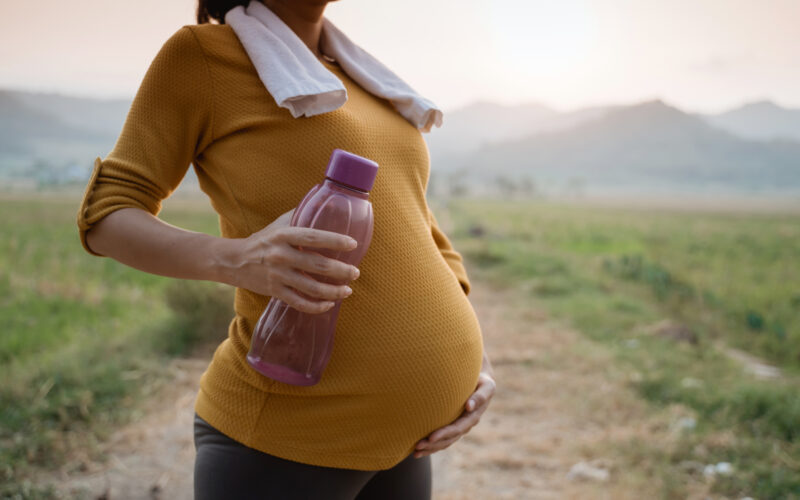Preeclampsia, formerly referred to as toxemia, has been used as a dramatic plot-twist in shows like Grey’s Anatomy, Call the Midwife, and Downton Abbey, likely because it’s familiar enough to be understood by the audience but also something that can get really bad, really fast. While it may make for good television, preeclampsia puts the lives of thousands of U.S. moms and babies at risk each year. But what if there was a simple way to reduce the risk of developing preeclampsia in the first place by supporting healthy placenta formation and cardiovascular health? Evidence suggests that exercise impacts multiple factors involved in the development of preeclampsia, and may help women protect themselves against factors associated with the disease.
What is preeclampsia?
According to the Preeclampsia Foundation, preeclampsia is persistent high blood pressure in pregnancy, also often associated with high levels of protein in urine (and the reason you need to pee in a cup at each OB visit), kidney or liver problems, decreased platelet levels, fluid in the lungs, seizures, or visual disturbances [1]. Preeclampsia affects 5-8% of U.S. pregnancies, has steadily been on the rise, and is a leading cause of pregnancy-related illness or death [1].
The main course of treatment for preeclampsia is to deliver the baby, but medication can be used to manage blood pressure and support the baby’s lung development to help buy time and offset some of the risks involved with preterm birth.
What causes preeclampsia?
While the exact cause of preeclampsia has yet to be understood, preeclampsia has a lot to do with endothelial dysfunction (endothelial cells are the cells that line the inside of blood vessels). According to Cleveland Clinic, this thin cell layer helps to manage the salt and fluid in the blood, form clots, prevent toxins from reaching tissues, regulate tissue inflammation, and dilate or constrict the blood vessels to alter blood pressure [1]. When the endothelium is not regulating properly, this can contribute to the high blood pressure that characterizes preeclampsia.
The next question is: What causes endothelial dysfunction? Pre-existing conditions such as diabetes, high cholesterol, smoking, and obesity are all known risk factors for endothelial dysfunction [1]. According to the National Health Service, if the blood vessels that serve the placenta do not form properly, the placenta will not form properly, either [2]. As explored in this 2012 journal article, this improperly formed placenta will send out placental fragments later in pregnancy under stress and contribute to a pro-inflammatory state in the body and endothelial dysfunction [3]. This 2015 article on endothelial dysfunction also lists oxidative stress, chronic inflammation, infection, and vitamin D deficiency as additional risk factors [4].
How might exercise prevent preeclampsia?
This 2012 article that explores the impact of exercise on preeclampsia outlines a number of ways that exercise positively affects the various factors involved in endothelial dysfunction, such as: improving overall health, improving placental development, reducing oxidative stress, reducing inflammation, and protecting the endothelium. Understanding how these factors affect overall health may help us understand how exercise could prevent preeclampsia.
Improving overall health
Even apart from pregnancy-specific effects, regular exercise can help to maintain a healthy weight and regulate blood sugar, reducing the risk of developing endothelial dysfunction and related problems during and outside of pregnancy [5].
Improving placental development
Exercise can contribute to the development of the placenta by temporarily creating a low-oxygen environment in the womb. This is important because low-oxygen environments stimulate the formation of new blood vessels, which is a crucial step in the formation of the placenta. This review also cites various other studies that report that the placentas of active mothers, compared to sedentary mothers, have less non-functional tissue, more functional tissue, higher mass, and greater surface area–all of which allows the placenta to be more efficient in exchanging gas and nutrients [5].
While placental development occurs during the first trimester, the placenta continues to grow throughout pregnancy, and exercise has been reported to increase production of a protein called placental growth factor, low levels of which are associated with, and used to diagnose, preeclampsia [5,6].
Reducing oxidative stress
Exercise has been shown to increase the body’s natural abilities to take care of free radicals and reactive oxygen species (ROS), both of which contribute to oxidative stress. Exercise both stimulates the creation of more mitochondria, which helps to lower ROS levels in the body, and decreases the amount of excess iron in the blood, preventing further ROS generation [5].
Reducing inflammation
Regular aerobic activity has been shown to have a short-term inflammatory effect in the body, but a long-term anti-inflammatory effect. Aerobic exercise has also been shown to reverse endothelial damage caused by inflammation [7,5].
It is important to note that intense physical activity can promote inflammation, so while it’s good to work up a sweat, you should still be able to talk normally while working out (working to catch your breath means the workout is too intense to be considered aerobic).
Protecting the endothelium
In preeclampsia, the placenta releases a protein that causes the endothelium to produce a compound called endothelin, which constricts the blood vessels and increases blood pressure. As mentioned, exercise can reduce proinflammatory factors, and this reduces endothelin and therefore blood pressure.
What other research studies say about whether exercise can prevent preeclampsia
In studies that have sought to test whether or not increasing physical activity protects against preeclampsia, a correlation between the amount of time sitting each day and developing preeclampsia has been observed.
However, even simple interventions like stretching every day are associated with lowered blood pressure, and (in an animal study) exercise resulted in better endothelial function and higher levels of vascular endothelial growth factor (a group of proteins that includes placental growth factor) [8,9,10]. However, the Cochrane review on whether exercise prevents preeclampsia currently states that more studies are needed to definitively say whether or not this is the case.
Guidelines for exercising in pregnancy
The American College of Obstetricians and Gynecologists recommends 10-30 minutes a day (totaling 150 minutes a week) of moderate aerobic activity for pregnant women [12]. For safety, ACOG also recommends starting small if you are new to exercise, and to stop and contact your pregnancy healthcare provider if you experience vaginal bleeding, dizziness, chest pain, headache, muscle weakness, calf pain or swelling, painful contractions, or if your water breaks [12].
Finding an activity that you enjoy and gets you moving every day can be a welcome mood-booster, can help with some of the aches and pains of pregnancy, improve overall health, prepare the body for labor, and potentially protect against one of the leading causes of pregnancy-related illness and death: preeclampsia. In other words, if you’ve been looking for a good reason to stick to a pregnancy exercise goal–this is it!
References:
[1] https://my.clevelandclinic.org/health/diseases/23230-endothelial-dysfunction [2] https://www.nhs.uk/conditions/pre-eclampsia/causes/#:~:text=Pre%2Declampsia%20is%20thought%20to,the%20blood%20vessels%20supplying%20it. [3] https://www.ahajournals.org/doi/full/10.1161/HYPERTENSIONAHA.111.184861#:~:text=The%20placentally%20derived%20debris%20or,syncytiotrophoblast%20microvesicles%2C%20and%20so%20on. [4] Park KH, Park WJ. Endothelial Dysfunction: Clinical Implications in Cardiovascular Disease and Therapeutic Approaches. J Korean Med Sci. 2015 Sep;30(9):1213-25. doi: 10.3346/jkms.2015.30.9.1213. Epub 2015 Aug 13. PMID: 26339159; PMCID: PMC4553666. [5] https://www.ahajournals.org/doi/10.1161/HYPERTENSIONAHA.112.194050 [6] Patel D, Yulia A. Placental growth factor testing for pre-eclampsia. Case Rep Womens Health. 2022 Jan 22;33:e00387. doi: 10.1016/j.crwh.2022.e00387. PMID: 35127458; PMCID: PMC8802869. [7] Kasapis C, Thompson PD. The effects of physical activity on serum C-reactive protein and inflammatory markers: a systematic review. J Am Coll Cardiol. 2005 May 17;45(10):1563-9. doi: 10.1016/j.jacc.2004.12.077. Epub 2005 Apr 25. PMID: 15893167. [8] Spracklen CN, Ryckman KK, Triche EW, Saftlas AF. Physical Activity During Pregnancy and Subsequent Risk of Preeclampsia and Gestational Hypertension: A Case Control Study. Matern Child Health J. 2016 Jun;20(6):1193-202. doi: 10.1007/s10995-016-1919-y. PMID: 26910608; PMCID: PMC5538351. [9] Yeo S. Adherence to walking or stretching, and risk of preeclampsia in sedentary pregnant women. Res Nurs Health. 2009 Aug;32(4):379-90. doi: 10.1002/nur.20328. PMID: 19415672; PMCID: PMC2895148. [10] https://scopeblog.stanford.edu/2011/10/18/could-exercise-before-and-during-early-pregnancy-lower-risk-of-pre-eclampsia/ [11] https://www.cochrane.org/CD005942/PREG_exercise-or-other-physical-activity-for-preventing-pre-eclampsia-and-its-complications [12] https://www.acog.org/womens-health/faqs/exercise-during-pregnancyAdditional Reading:
Preeclampsia: What causes it, who develops it, and how do you prevent it?











